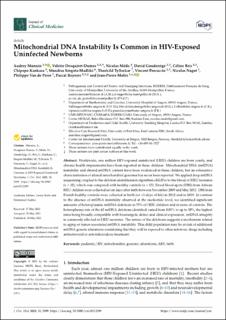| dc.contributor.author | Monnin, Audrey | |
| dc.contributor.author | Desquiret-Dumas, Valérie | |
| dc.contributor.author | Meda, Nicolas | |
| dc.contributor.author | Goudenège, David | |
| dc.contributor.author | Bris, Céline | |
| dc.contributor.author | Kankasa, Chipepo | |
| dc.contributor.author | Singata-Madliki, Mandisa | |
| dc.contributor.author | Tylleskär, Thorkild | |
| dc.contributor.author | Procaccio, Vincent | |
| dc.contributor.author | Nagot, Nicolas | |
| dc.contributor.author | Van De Perre, Philippe | |
| dc.contributor.author | Reynier, Pascal | |
| dc.contributor.author | Molès, Jean-Pierre | |
| dc.date.accessioned | 2022-02-04T07:47:22Z | |
| dc.date.available | 2022-02-04T07:47:22Z | |
| dc.date.created | 2021-10-21T11:14:32Z | |
| dc.date.issued | 2021 | |
| dc.identifier.issn | 2077-0383 | |
| dc.identifier.uri | https://hdl.handle.net/11250/2977026 | |
| dc.description.abstract | Worldwide, one million HIV-exposed uninfected (HEU) children are born yearly, and chronic health impairments have been reported in these children. Mitochondrial DNA (mtDNA) instability and altered mtDNA content have been evidenced in these children, but an exhaustive characterization of altered mitochondrial genomes has never been reported. We applied deep mtDNA sequencing coupled to the deletion identification algorithm eKLIPse to the blood of HEU neonates (n = 32), which was compared with healthy controls (n = 15). Dried blood spots (DBS) from African HEU children were collected seven days after birth between November 2009 and May 2012. DBS from French healthy controls were collected at birth (or <3 days of life) in 2012 and in 2019. In contrast to the absence of mtDNA instability observed at the nucleotide level, we identified significant amounts of heteroplasmic mtDNA deletions in 75% of HEU children and in none of controls. The heteroplasmy rate of the 62 mtDNA deletions identified varied from 0.01% to up to 50%, the highest rates being broadly compatible with bioenergetic defect and clinical expression. mtDNA integrity is commonly affected in HEU neonates. The nature of the deletions suggests a mechanism related to aging or tumor-associated mtDNA instability. This child population may be at risk of additional mtDNA genetic alterations considering that they will be exposed to other mitotoxic drugs including antiretroviral or anti-tuberculosis treatment. | en_US |
| dc.language.iso | eng | en_US |
| dc.publisher | MDPI | en_US |
| dc.rights | Navngivelse 4.0 Internasjonal | * |
| dc.rights.uri | http://creativecommons.org/licenses/by/4.0/deed.no | * |
| dc.title | Mitochondrial DNA Instability Is Common in HIV-Exposed Uninfected Newborns | en_US |
| dc.type | Journal article | en_US |
| dc.type | Peer reviewed | en_US |
| dc.description.version | publishedVersion | en_US |
| dc.rights.holder | Copyright 2021 by the authors | en_US |
| dc.source.articlenumber | 2399 | en_US |
| cristin.ispublished | true | |
| cristin.fulltext | original | |
| cristin.qualitycode | 1 | |
| dc.identifier.doi | 10.3390/jcm10112399 | |
| dc.identifier.cristin | 1947527 | |
| dc.source.journal | Journal of Clinical Medicine | en_US |
| dc.identifier.citation | Journal of Clinical Medicine. 2021, 10 (11), 2399. | en_US |
| dc.source.volume | 10 | en_US |
| dc.source.issue | 11 | en_US |

